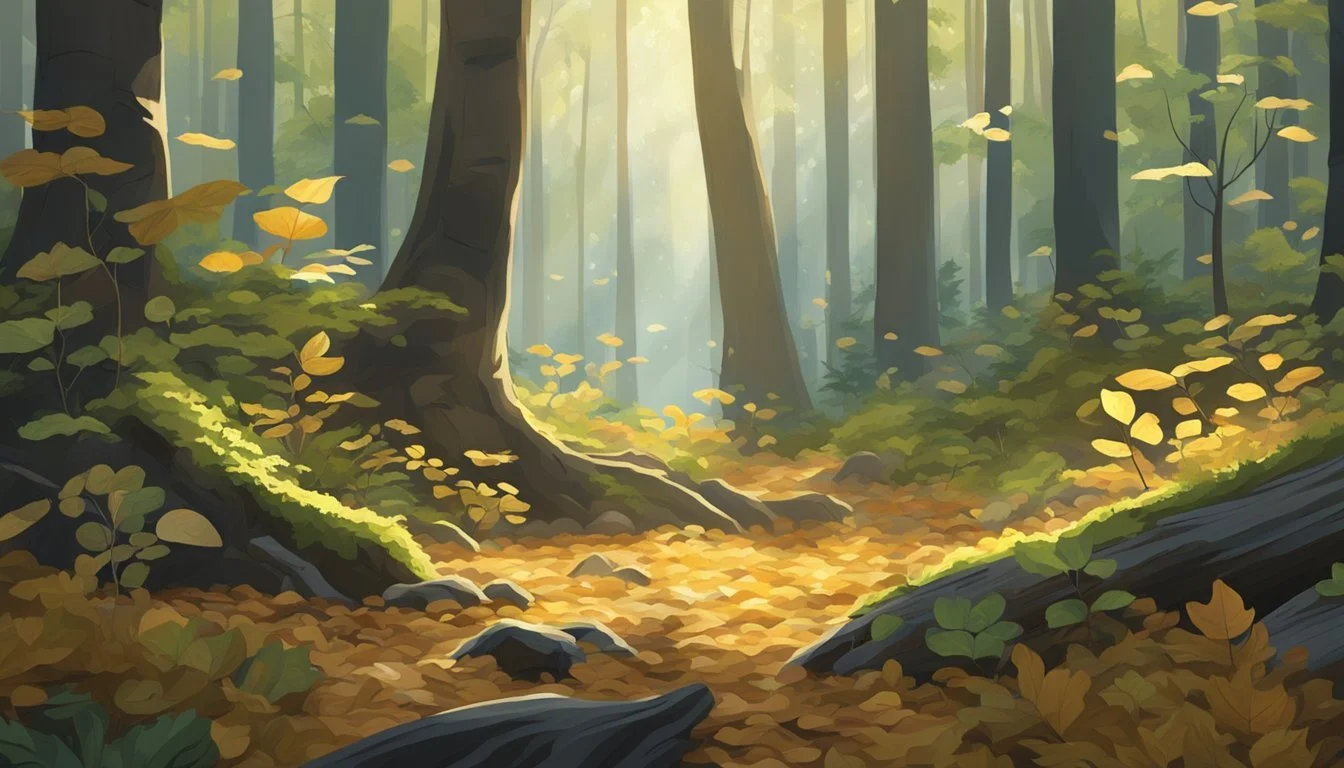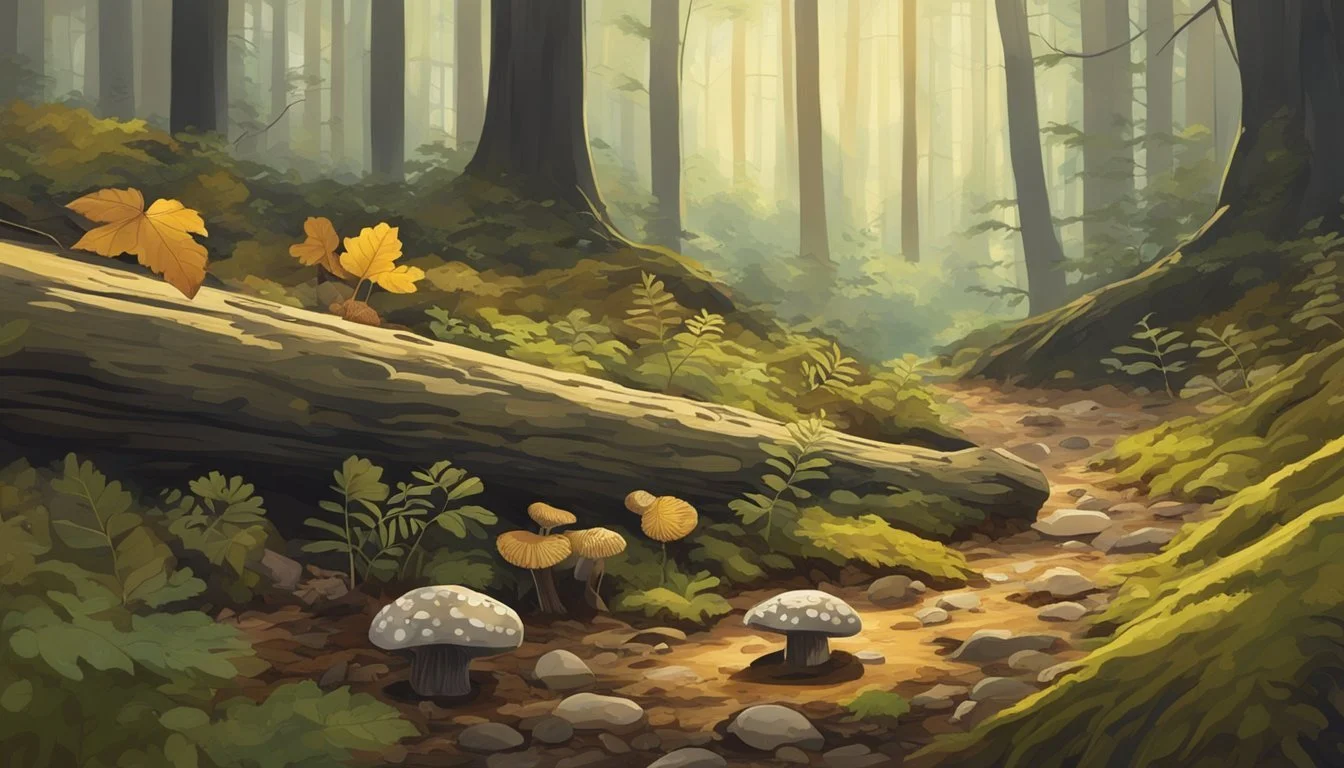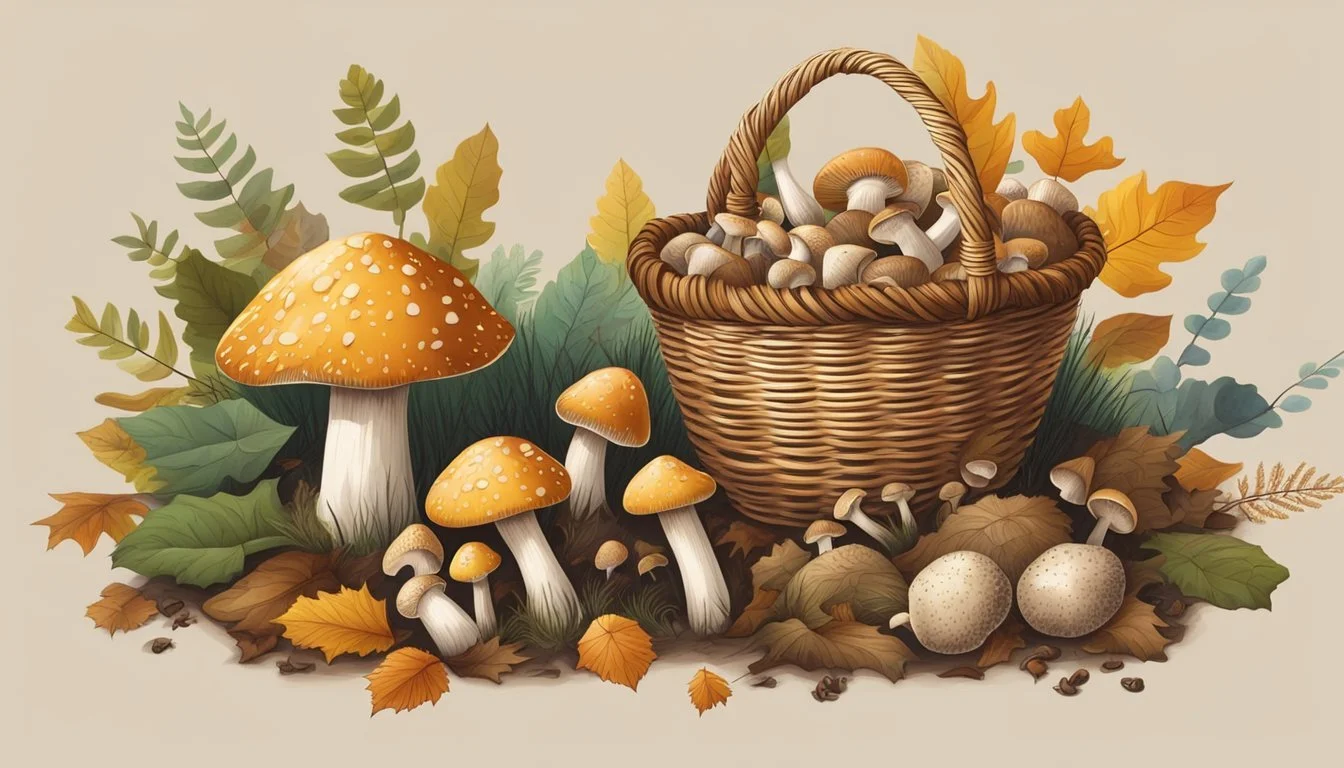South Central Mushroom Hunting
A Guide to Finding Wild Edibles
For enthusiasts in the morel mushroom hunting community, South Central is a treasure trove of opportunities. With its diverse landscapes and rich forests, this region offers an ideal environment for mushroom foraging. Whether you’re a seasoned hunter or a beginner, the area promises rewarding finds and thrilling adventures.
It’s well known that morels thrive in specific conditions and South Central’s climate provides just that. Typically, morels begin to appear in early spring when temperatures start to climb. Daytime temps in the 70s and nighttime lows in the 50s create the perfect setting for these prized fungi to flourish. This predictable pattern makes the region a favorite among hunters.
In South Central, understanding the terrain and utilizing resources like the Historic Wildfire Map Layer can significantly boost your success. Turning on map layers showing public and private land boundaries, coupled with historical wildfire data, can pinpoint promising hunting grounds. This method ensures that you’re always in the best spots, maximizing both your time and yields in the field.
Understanding Morel Mushrooms
Morel mushrooms are prized for their unique appearance and gourmet flavor. They flourish under specific conditions, making them both a challenge and a delight to find.
Characteristics of Morels
Morel mushrooms stand out due to their distinctive conical shape and sponge-like texture. The cap resembles a honeycomb, which ranges in color from yellow to brown or black, depending on the species.
These fungi typically have a hollow stem and cap.
Morels thrive in moist environments such as forests with ample decaying organic matter. The ideal ground temperature for morel growth is around 50°F, often coinciding with spring rains.
These conditions enable the morels to absorb nutrients efficiently, resulting in their rapid growth.
Proper identification is vital, as false morel species can be toxic.
Varieties of Morels
There are primarily two main varieties: yellow morels (Morchella esculenta) and black morels (Morchella elata).
Yellow morels are also known as common morels and are recognizable by their lighter, yellowish caps. They are typically found in hardwood forests.
Black morels have darker, ridged caps and often appear earlier in the season than their yellow counterparts. They favor coniferous forests and burned areas.
These distinctions in habitat and appearance assist hunters in accurately identifying and locating morels for foraging.
Preparation for Morel Hunting
Preparation for morel hunting involves gathering the proper equipment, ensuring safety and obtaining necessary permissions, identifying false morels, and understanding the importance of soil conditions. For a successful foray, each of these factors must be carefully considered.
Equipment and Gear
Proper gear is essential for a successful outing. A mesh bag is recommended as it allows spores to fall through, aiding in mushroom propagation.
Field guides and books on mushroom identification and tree identification are invaluable. These materials help hunters recognize morels and understand their preferred habitats.
Comfortable hiking boots, weather-appropriate clothing, and a walking stick for stability on rough terrain are also necessary. Carrying a small knife or scissors helps to cleanly cut the mushrooms and prevent damage.
Safety and Permissions
Safety starts with awareness of the area. Hunters should familiarize themselves with public lands, as permissions and permits may differ.
On private land, explicit permission from landowners is required to avoid trespassing. Always carry identification, a map, and a fully charged phone.
Inform someone of your whereabouts before heading out. Morel hunters should be mindful of their surroundings, as uneven terrain can pose risks. Besides, knowing local wildlife and potential hazards is crucial for a safe trip.
Identifying False Morels
False morels, particularly species like Gyromitra, can be dangerous. They often resemble true morels but have notable differences.
True morels have a honeycomb-like cap with pits and ridges, while false morels are more lobed and wrinkled. When cut open, true morels are hollow, whereas false morels usually contain cotton-like fibers.
Foragers should carry reliable field guides and consult them carefully. The risk of false morel consumption underlines the need for accurate identification.
Understanding Soil Conditions
Soil conditions significantly influence morel fruiting. Ideal soil temperatures for morel emergence range between 45 to 60 degrees Fahrenheit.
Consistent air temperatures above 60°F and soil moisture levels also play a role. South-facing slopes, which warm up earlier, are prime spots to search.
After snowmelt, when the forest floor starts to warm, provides optimal hunting conditions. Foragers must pay attention to these environmental cues to maximize their chances of finding morels.
Understanding these factors is crucial for anticipating the best time to hunt.
When to Hunt for Morels
Morel mushrooms are typically found during specific seasonal windows, influenced by temperature and weather patterns. Regional differences also play a crucial role in determining the optimal hunting times.
Seasonal Timing
The best time to hunt for morel mushrooms varies by region. In the South, morels tend to appear in early spring, around April, when daytime temperatures reach the 70s and nighttime lows are in the 50s.
In the Midwest and Upper Midwest, such as Missouri and Wisconsin, the prime hunting season typically starts in late April and continues through May. The season may extend into early summer in some cooler regions, but spring is generally the key period for successful hunting.
Weather Impact on Hunting
Weather conditions significantly affect morel mushroom emergence. Consistent daytime temperatures in the 60s to 70s and nighttime temperatures around 50 degrees are ideal.
Rainfall is crucial; morels thrive after a good rain followed by warm days. Snowmelt also contributes to the moisture levels needed for morel growth. High soil humidity, often found in forested areas, supports better mushroom development compared to grassy regions.
Regional Considerations
Different regions have specific optimal times for morel hunting. In the southern areas, morels are more common in early April. The Northeast and Upper Midwest, including states like Pennsylvania and Wisconsin, see morels a bit later, often starting in late April and peaking in May.
Missouri offers a broad hunting window due to its diverse terrain. Morels can be found from the north to the south of the state, though areas heavily impacted by development may present fewer opportunities.
Where to Find Morel Mushrooms
Finding morel mushrooms requires knowing the ideal habitat, recognizing the right tree associations, and understanding the effects of natural disturbances. Each of these factors plays a crucial role in a successful morel hunt.
Ideal Habitats
Morel mushrooms favor specific habitats that provide the right conditions for growth. They are often found in moist areas with well-draining soil, such as river bottoms and the edges of forests. Southward and westward slopes that receive ample sunlight during early spring are ideal for morels due to their warmer soil temperatures.
Forests with a mix of deciduous trees present a fertile ground for morels. Grassy areas on the edges of woods are also good places to look. Maps highlighting historical wildfire areas and public lands can guide hunters to prime locations.
Tree Associations
Certain trees have symbiotic relationships with morel mushrooms, providing the necessary nutrients for their growth. Trees such as ash, elm, cottonwoods, and tulip poplars are common hosts for morels. The mushrooms often grow near the roots of these trees, particularly in old orchards or forests.
Morels also tend to thrive around dying or recently dead trees. Elm trees suffering from diseases or recently fallen cottonwoods can be hotspots. Knowing how to identify these trees can greatly increase the odds of finding morels.
Effects of Natural Disturbances
Natural disturbances like wildfires, logging, and floods can significantly affect morel mushroom growth. Burn sites from recent wildfires create conditions that are particularly favorable for morel proliferation. The nutrient-rich ash left behind by fires enhances soil fertility, making these areas prime for mushroom hunters.
Logging activities that disrupt the forest floor can also create favorable conditions for morels. Areas that have been selectively logged or cleared of certain trees may see an increase in mushroom growth. Monitoring maps that show recent wildfire activities and logged areas can help hunters find productive hunting grounds.
By focusing on these aspects, morel mushroom hunters can improve their chances of a successful harvest.
Techniques for Successful Morel Hunting
Morel hunting requires careful timing, knowledge of the right environmental conditions, and a commitment to sustainable practices. Understanding how to spot morels, the proper way to pick and collect them, and the importance of environmental conservation will significantly increase the likelihood of a successful hunt.
Spotting Morels
Success in finding morels hinges on knowing where and when to look. Morels thrive in early spring, usually just after the snow melts and the forest floor starts to warm. Optimal conditions include soil temperatures ranging from 50-55 degrees Fahrenheit.
South-facing slopes are prime locations because they warm up faster than other areas, making them conducive for morel growth. Additionally, look near dead or dying trees, especially those with bark still attached, and areas with light ground disturbances, such as former stream beds or trails.
Leaves and underbrush may conceal morels, so hunters need to be keen-eyed and patient. It helps to scan the ground slowly, focusing on spots of the forest floor where moisture is retained but not waterlogged.
Picking and Collecting Morels
When harvesting morels, it is essential to collect them correctly to ensure future growth and sustainability. Use a knife to cut the mushroom at the base, which helps protect the mycelium in the soil for future morel proliferation.
Gather morels in a mesh bag. This technique allows spores to disseminate as you move through the forest, potentially fostering more growth. Avoid plastic bags as they can trap moisture and cause the mushrooms to spoil.
Pay attention to the size of the morels. Smaller, younger mushrooms are typically more flavorful and textured, while larger ones can become hollow and more prone to insects. Always inspect for any signs of pests and avoid picking morels in heavily polluted areas.
Environmental Conservation
Sustainability should be a top priority for mushroom hunters. Practice mindful foraging to ensure that the forest remains healthy for future generations. Avoid over-harvesting and only take what you need or can use.
Respect wildlife and their habitats by treading lightly and minimizing disturbances. Stick to existing trails whenever possible and refrain from turning over large amounts of soil which can disrupt the natural ecosystem.
Educating others on the importance of environmental conservation helps spread awareness and promotes a culture of respect for nature. Contributing to a sustainable environment ensures that morels will continue to be a treasured find for all.
After the Hunt
After a successful mushroom hunt, it is crucial to handle, clean, and prepare your morel mushrooms properly to maintain their rich, earthy flavor.
Handling and Storage
To keep the mushrooms fresh, store them in a paper bag or a basket. Avoid using plastic bags, which can trap moisture and cause the morels to spoil faster.
For long-term storage, dehydration is a popular method. Use a dehydrator set at 110 degrees Fahrenheit for 8-10 hours or place them in an oven at the lowest setting with the door slightly open.
Morels can also be frozen. Once dehydrated, store them in airtight jars and place them in the freezer for up to a year. Make sure to label the jars with the date.
Cleaning and Preparing Morels
Cleaning morels is an essential step to remove any dirt or insects. Start by cutting the mushrooms in half lengthwise, checking for any unwanted guests.
Rinse them gently under cool water but avoid soaking them excessively, as they can absorb water and become mushy.
Pat them dry with paper towels. Some foragers recommend a light brine solution (salt water) to dislodge hidden dirt, but this is optional and should be done quickly.
Cooking with Morels
Morels are highly prized for their nutty, earthy flavor, making them a versatile ingredient in the kitchen. Before cooking, rehydrate dried morels by soaking them in warm water or broth for about 20 minutes.
They pair exceptionally well with dishes rich in butter and cream. Morels can be sautéed with butter and garlic for a simple side dish or added to sauces, soups, and stews.
For a gourmet touch, serve them alongside steak to complement the meat's flavors. Avoid overpowering spices to let the unique taste of the morels shine through.
Community and Resources
South Central mushroom hunters benefit from a vibrant community and numerous resources. These include local foraging groups that share key information, organize events, and support both novice and experienced enthusiasts.
Local Foraging Groups
Local foraging groups are crucial for anyone interested in mushroom hunting. They provide networking opportunities and critical knowledge sharing. In South Central areas, groups such as the Eastern Penn Mushroomers, Central PA Mushroom Club, and Western Pennsylvania Mushroom Club are notable.
These groups frequently organize forays, workshops, and identification sessions. Members can participate in these activities to learn which mushrooms are safe to consume and how to identify them accurately. Additionally, they offer a platform for sharing successful foraging locations and best practices.
Morel Hunting Economics
Morel mushroom hunting has both commercial and local economic impacts. The market for morel mushrooms influences commercial hunters, while local economies benefit from foraging activities and related tourism.
Commercial Hunting
Commercial hunting of morel mushrooms is a lucrative activity. Morel mushrooms fetch a high price in markets due to their unique flavor and difficulty in cultivation. Prices can range from $20 to $50 per pound, depending on quality and demand.
Commercial hunters often supply restaurants, gourmet shops, and farmers' markets. The high value of morels stimulates competition and draws hunters during peak season, typically early spring. The need for knowledge on mushroom hotspots and foraging techniques is crucial for commercial success.
Impact on Local Economies
Morel hunting also boosts local economies. Many small towns and rural areas see increased activity during morel season as hunters travel to these regions. This influx can benefit local businesses such as restaurants, hotels, and outdoor supply stores.
Festivals and guided foraging tours often attract tourists, further contributing to economic activity. Additionally, morels sold at local markets provide income for residents. This seasonal activity creates a temporary but significant economic uplift in areas known for abundant morel growth.










